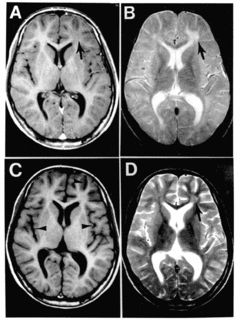 W
WMeasles is a highly contagious infectious disease caused by measles virus. Symptoms usually develop 10–12 days after exposure to an infected person and last 7–10 days. Initial symptoms typically include fever, often greater than 40 °C (104 °F), cough, runny nose, and inflamed eyes. Small white spots known as Koplik's spots may form inside the mouth two or three days after the start of symptoms. A red, flat rash which usually starts on the face and then spreads to the rest of the body typically begins three to five days after the start of symptoms. Common complications include diarrhea, middle ear infection (7%), and pneumonia (6%). These occur in part due to measles-induced immunosuppression. Less commonly seizures, blindness, or inflammation of the brain may occur. Other names include morbilli, rubeola, red measles, and English measles. Both rubella, also known as German measles, and roseola are different diseases caused by unrelated viruses.
 W
WAcute disseminated encephalomyelitis (ADEM), or acute demyelinating encephalomyelitis, is a rare autoimmune disease marked by a sudden, widespread attack of inflammation in the brain and spinal cord. As well as causing the brain and spinal cord to become inflamed, ADEM also attacks the nerves of the central nervous system and damages their myelin insulation, which, as a result, destroys the white matter. It is often triggered by a viral infection or specific non-routine vaccinations.
 W
WConjunctivitis, also known as pink eye, is inflammation of the outermost layer of the white part of the eye and the inner surface of the eyelid. It makes the eye appear pink or reddish. Pain, burning, scratchiness, or itchiness may occur. The affected eye may have increased tears or be "stuck shut" in the morning. Swelling of the white part of the eye may also occur. Itching is more common in cases due to allergies. Conjunctivitis can affect one or both eyes.
 W
WJohn Franklin Enders was an American biomedical scientist and Nobel Laureate. Enders has been called "The Father of Modern Vaccines."
 W
WMeasles is extremely contagious, but surviving the infection results in lifelong immunity, so its continued circulation in a community depends on the generation of susceptible hosts by birth of children. In communities which generate insufficient new hosts the disease will die out. This concept was first recognized by Bartlett in 1957, who referred to the minimum number supporting measles as the critical community size (CCS). Analysis of outbreaks in island communities suggested that the CCS for measles is c. 250,000.
 W
WMaurice Ralph Hilleman was an American microbiologist who specialized in vaccinology and developed over 40 vaccines, an unparalleled record of productivity. Of the 14 vaccines routinely recommended in current American vaccine schedules, he developed eight: those for measles, mumps, hepatitis A, hepatitis B, chickenpox, Neisseria meningitidis, Streptococcus pneumoniae and Haemophilus influenzae bacteria. He also played a role in the discovery of the cold-producing adenoviruses, the hepatitis viruses, and the potentially cancer-causing virus SV40.
 W
WKoplik's spots are a prodromic viral enanthem of measles manifesting two to three days before the measles rash itself. They are characterized as clustered, white lesions on the buccal mucosa and are pathognomonic for measles. The textbook description of Koplik spots is ulcerated mucosal lesions marked by necrosis, neutrophilic exudate, and neovascularization. They are described as appearing like "grains of salt on a reddish background", and often fade as the maculopapular rash develops. As well as their diagnostic significance they are important in the control of outbreaks. Their appearance, in context of a diagnosed case, before they reach maximum infectivity, permits isolation of the contacts and greatly aids control of this highly infectious disease.
 W
WMeasles morbillivirus, formerly called measles virus (MV), is a single-stranded, negative-sense, enveloped, non-segmented RNA virus of the genus Morbillivirus within the family Paramyxoviridae. It is the cause of measles. Humans are the natural hosts of the virus; no animal reservoirs are known to exist.
 W
WMeasles vaccine is a vaccine that prevents measles. Nearly all of those who do not develop immunity after a single dose develop it after a second dose. When rates of vaccination within a population are greater than 92%, outbreaks of measles typically no longer occur; however, they may occur again if rates of vaccination decrease. The vaccine's effectiveness lasts many years. It is unclear if it becomes less effective over time. The vaccine may also protect against measles if given within a couple of days after exposure to measles.
 W
WMelanie's Marvelous Measles is a self-published children's book written by Australian author and anti-vaccine activist Stephanie Messenger. Through its story, the book claims, contrary to scientific data, that contracting measles is beneficial to health, and that vaccines are ineffective.
 W
WThe MMR vaccine is a vaccine against measles, mumps, and rubella. The first dose is generally given to children around 9 to 15 months of age, with a second dose at 15 months to 6 years of age, with at least 4 weeks between the doses. After two doses, 97% of people are protected against measles, 88% against mumps, and at least 97% against rubella. The vaccine is also recommended in those who do not have evidence of immunity, those with well-controlled HIV/AIDS, and within 72 hours of exposure to measles among those who are incompletely immunized. It is given by injection.
 W
WSubacute sclerosing panencephalitis (SSPE)—also known as Dawson disease—is a rare form of chronic progressive brain inflammation caused by slow infection with certain defective strains of hypermutated measles virus. The condition primarily affects children, teens, and young adults. It has been estimated that about 1 in 10,000 people who get measles will eventually develop SSPE. However, a 2016 study estimated that the rate for babies who contracted measles was as high as 1 in 609. No cure for SSPE exists, and the condition is almost always fatal. SSPE should not be confused with acute disseminated encephalomyelitis, which can also be caused by the measles virus, but has a very different timing and course.